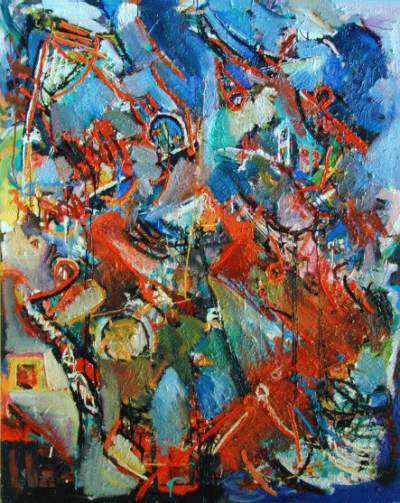BACK
A Generative Theory of Shape
by Michael
Leyton
Center for
Discrete Mathematics & Theoretical Computer Science (DIMACS),
Rutgers University, USA
www.rci.rutgers.edu/~mleyton/homepage.htm
November
24, 2006, Seminar Rooms, BPB
@
Goldsmiths, noon -- 13h
Digital Studios @
Goldsmiths College
 download a
PDF version of this event's announcement.
download a
PDF version of this event's announcement.

"Exile" by M. Leyton, 1992.
(more
artworks)
Abstract
This talk gives an introduction to my book "A Generative
Theory of Shape" (Springer, 2001). The purpose of the book is
to develop a generative theory that has two properties regarded as
fundamental to intelligence:
- maximizing transfer of structure
and
- maximizing recoverability of the
generative operations.
These two properties are particularly important in the representation
of complex shape – which is the main concern of the book. The primary
goal of the theory is the conversion of complexity into
understandability. For this purpose, a mathematical theory is presented
of how understandability is created in a structure. This is achieved by
developing a group-theoretic approach to formalizing transfer and
recoverability. To handle complex shape, a new class of groups is
invented, called unfolding groups.
These unfold structure from a maximally collapsed version of that
structure. A principal aspect of the theory is that it develops a new
algebraic formalization of major object-oriented concepts such as
inheritance. The consequence is an object-oriented theory of geometry.
As a result, the book establishes a representational language for
product and project description, that is interoperable by virtue of the
principles on which the theory is based: transfer (reusability) and
recoverability (traceability). Most crucially, in this theory, intelligence is brought into the
very foundations of geometry.
The book gives extensive applications of the theory to CAD/CAM, human
and machine vision, robotics, software engineering, and physics.
For example, the theory is used to give new and detailed insights into
the main stages of mechanical CAD/CAM: part-design, assembly and
machining. And within part-design, an extensive analysis is given of
sketching, alignment, dimensioning, resolution, editing, sweeping,
feature-addition, and intent-management. The equivalent analysis is
also done for architectural design. In robotics, several levels of
analysis are developed for manipulator structure and kinematics.
In software, a new theory is given of the principal factors such as
text and class structure, object creation cloning and modification, as
well as inheritance and hierarchy prediction. In physics, a new theory
is given of the conservation laws, and motion decomposition theorems in
classical and quantum mechanics. In perception, extensive theories are
developed for Gestalt grouping criteria, orientation and form, the
prototype phenomena, and the main Gestalt motion phenomena (induced
motion, separation of systems, the Johannson relative/absolute motion
effects.
Springer-Verlag
allows the book to be viewed on-line at institutions that have a
Springer subscription.
Book
review by Stephen Wassell, in Nexus Network Journal, v.6(1), Spring
2004.
BACK
Last update: Nov. 22, 2006.

 download a
PDF version of this event's announcement.
download a
PDF version of this event's announcement.